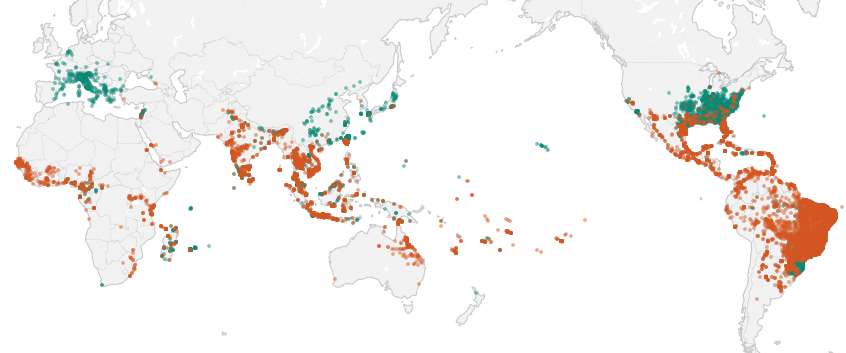A worldwide study has published the largest and most complete data base on the location and presence of yellow fever mosquito (Aedes aegypti) and tiger mosquito (Aedes albopictus) adults, pupae, larvae, and eggs covering the period 1960 to 2014. This collection of data was published in July 2015 in Nature’s Scientific Data, an open-access portal for high-value data.
The following interactive map shows the presence data for the two species. This is a visualisation tool for historic data of high interest, including information for some periods for which it is difficult to obtain precise data, for example the 1950s and 1970s.
See the map on the original source
Understanding the distributions of the species is crucial for disease prevention
The yellow fever mosquito (Ae. aegypti) and the tiger mosquito (Ae. albopictus) are vectors of arboviruses of global significance, including yellow fever, chikungunya, and zika. Arboviruses are a group of viruses transmitted by arthropods, which serve as vectors. From the standpoint of public health protection, knowing and understanding the geographical distribution and presence of these vector species is quite important for planning disease prevention and control and different management interventions. The incidence of these diseases has increased significantly in the last 50 years since these two mosquito species have been able to expand into new geographical areas.
Both mosquitos use manmade containers to raise their larvae, which is why they have become abundant in urban areas. “The yellow fever mosquito is often found in houses while the tiger mosquito is more associated with vegetation and is most predominant in suburban and rural areas,” explains Dr. Roger Eritja, entomologist from the Baix Llobregat Mosquito Control Service.
What is the state of these mosquitos in Spain?
There aren’t yet any populations of Aedes aegypti in Spain. On the other hand, the tiger mosquito (Aedes albopictus) is widely established in Spain, especially along the coasts of Catalonia and Valencia and in Southern Spain. However, increases in global mean temperature favour the eventual appearance of Aedes aegypti in Spain. During period 1650 to 1850 it had once been abundant as a result of introductions associated with commerce and the transport of goods. “The tiger mosquito arrived with the transport of goods, so you have to take into account that the yellow fever mosquito could arrive the same way,” says Frederic Bartumeus, director of the project. Recently, the Canarian Government has announced the finding of some individuals of yellow fever mosquito at the Fuerteventura island, according to the Entomological Surveillance System actions.




